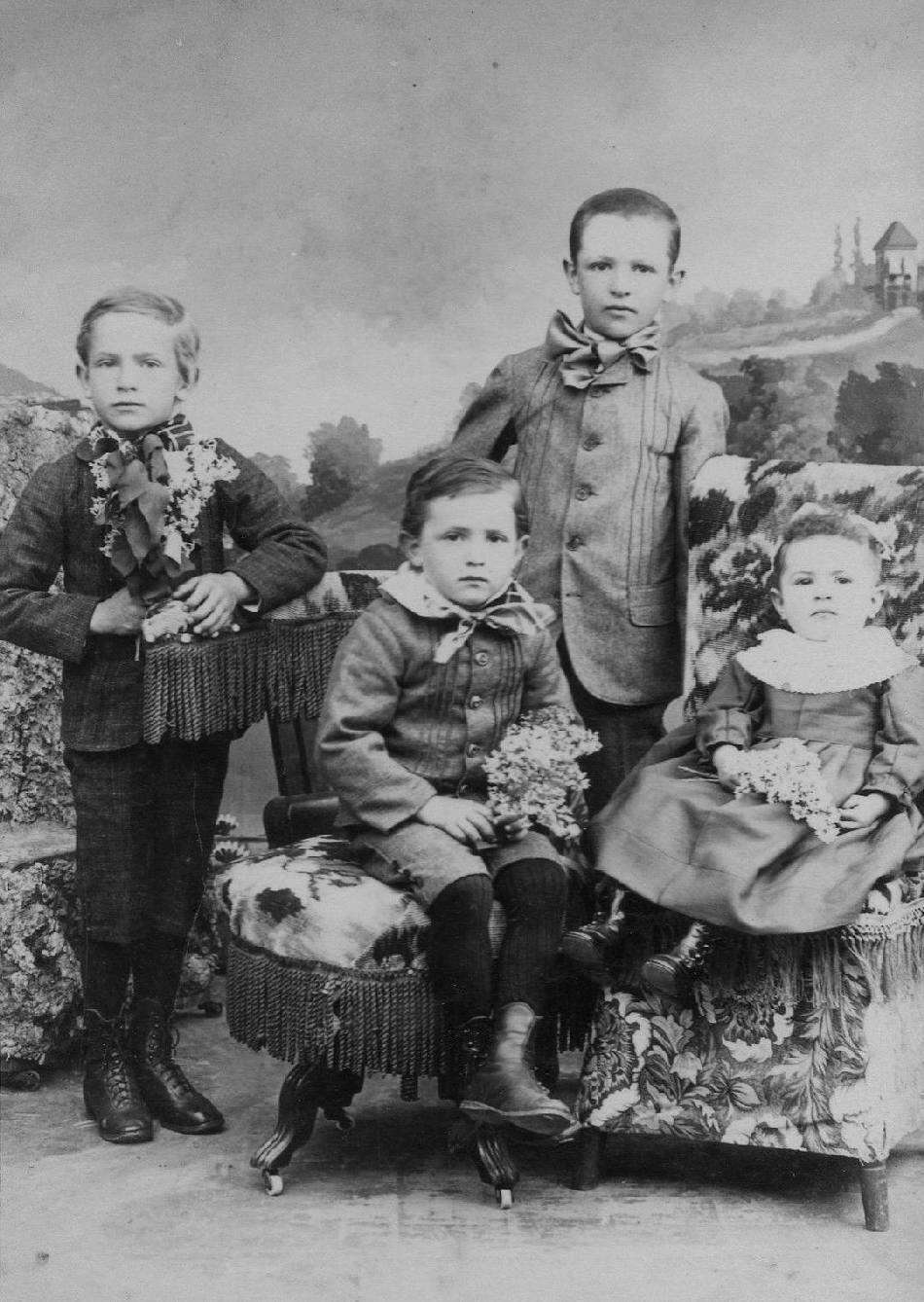
United States Boys' Suits Chronology: The 1890s--Jacket Styles

Figure 1.-- These four siblings are unidentified. They are clearly three boys about 5-11 years old. We are not sure about the baby. They look to be wear similar kneepants suit, although the middle boy's suit is a darker color. We at first thought they were collar-buttoning jackets, but if you look closely at the older boy uou can see a small, high-set lapel. We can not tell because of the floppy bows and flowers if the ither two boys have the same styled jacket or collar-buttoning jackets. The cabinet cardos undated, but looks like the 1890s to us. The studio was H.S. Deibert in Schuylkill Haven, Pennsylvania.
|
|
There were many different kinds of suits worn by American boys in the 1890s. We still note kilt suits and Fauntleroy suits for younger boys. The Fauntleroy suit cotinued to be a popular style. We note boys from a wider social cross section wearing Fauntleroy suits in the 1890s. They were commonly, but not always done in black velvet. The Fauntleroy suit cotinued to be a popular style. This was the height of the Fauntleroy craze. Some kilt suits were done with Fauntleroy styling. Sailor suits were a very popular choice in the 1890s and worn by somewhat older boys. We note sailor suits earlier, It was not until the 1890s, however, that the sailor suit became a standard style for boys and traditional styling becomes increasingly standard. Older boys wore more modern-looking sack suits. Suits were a very important garment at the time. Boys did not have large wardrobes or stylish leisure clothing. For casual occasions boys might wear just shit sleeces or during the summer or an old suit jacker during the winter. Most boys wore suits to school. We see quite a range of suit styles. We see both collar buttoning jackets and lapel jackets. A good example of the different types are the suits worn by boys at a Lexington school in 1892. Many destinctive styles appeared such as Norfolk suits. There were single- and double-breasted suits. Lapels could be small and set quite high, but this varied. And we continue to see a lot of boys wearting collar-buttoning jackets rather than lapel jackets. We see both knee pants and long pants at the beginning of the decade. Knee pants were becoming standard at the beginning of the decade. And by the end of the decade knee pants had become standard with all but the older teenagers wearing them. They were not quite as common in rural areas.
There were many different kinds of suits worn by American boys in the 1890s. There were several popular styles for younger boys. We still note kilt suits and Fauntleroy suits for younger boys. The Fauntleroy suit cotinued to be a popular style. We note boys from a wider social cross section wearing Fauntleroy suits in the 1890s. They were commonly, but not always done in black velvet. The Fauntleroy suit cotinued to be a popular style. This was the height of the Fauntleroy craze. Some kilt suits were done with Fauntleroy styling. The classic Fauntleroy suit was done with cut-away jackets to dispaly the fancy blouse. Older boys might wear lapel sack suits with Fauntleroy items added like large collars and floppy bows. Sailor suits were a very popular choice in the 1890s and worn by somewhat older boys. We note sailor suits earlier, It was not until the 1890s, however, that the sailor suit became a standard style for boys and traditional styling becomes increasingly standard. Another popular style for younger boys was the collar-buttoning jacket. We see these jackets both with and without Fauntleroy elements like large collars and floppy bows. These collar-buttoning jackets are a liitle difficult to identify with any certainty from the photographic record. This was because of the large collars and bows as well as the fact that some lapel jackets in the 1890s had very small, high-set lapels which can be seen here (figure 1).
Older boys wore more modern-looking sack suits. Suits were a very important garment at the time. Boys did not have large wardrobes or stylish leisure clothing. For casual occasions boys might wear just shit sleeces or during the summer or an old suit jacket during the winter. Most boys wore suits to school. There were two basic suit types. We see both collar buttoning jackets and lapel jackets. The collar buttoning jackets were mostly for younger boys and declining in popularity. Both younger and older boys wore the lapel jacket sack suits which was becoming the standard styles. We see quite a range of suit styles. Yhe two major basic styles were single- and double-breasted suits. A good example of the different types are the suits worn by boys at a Lexington school in 1892. Many destinctive style detailing appeared such as Norfolk suits. You can see some Norfolk styling here (figure 1). There were single and double breasted suits. Lapels could be small and set quite high, but this varied. We see both knee pants and long pants at the beginning of the decade. Knee pants were becoming standard at the beginning of the decade. And by the end of the decade knee pants had become standard with all but the older teenager wearing them. They were not quite as common in rural areas.
HBC

Navigate the Boys' Historical Clothing Web Site:
[Return to the Main U.S. 1890s suit cronology page]
[Return to the Main U.S. 19th century suit cronology page]
[Return to the Main U.S. suit page]
[Introduction]
[Activities]
[Biographies]
[Chronology]
[Clothing styles]
[Countries]
[Bibliographies]
[Contributions]
[FAQs]
[Glossary]
[Images]
[Links]
[Registration]
[Tools]
[Boys' Clothing Home]
Created: 2:11 PM 8/5/2017
Last updated: 6:08 AM 6/9/2019



